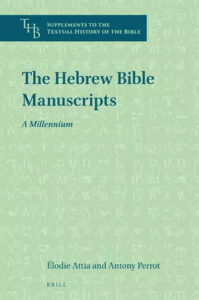O estudo da Bíblia, como de qualquer outro texto antigo, baseia-se em manuscritos que registram várias etapas de sua transmissão textual.
Quando os fundadores da abordagem crítica do texto bíblico hebraico – Benjamin Kennicott (1718-1783) em Oxford e Giovanni Bernardo de Rossi (1742-1831) na Itália – reuniram suas respectivas comparações de manuscritos, as mais antigas testemunhas do texto que eles possuíam eram do século XII d.C.
Desde as publicações deles no final do século XVIII, o estudo da Bíblia Hebraica beneficiou-se felizmente da descoberta de manuscritos importantes até então desconhecidos.
desconhecidos.
A primeira grande descoberta foi A Genizah do Cairo, termo que abrange cerca de 300 mil fragmentos de uma variedade de escritos literários e documentais, mantidos hoje em setenta e duas coleções diferentes em todo o mundo, que foram recuperados por estudiosos, viajantes e antiquários da genizah da sinagoga Ben Ezra em Fustat, de outras sinagogas e do cemitério judaico de Basâtîn no Cairo Antigo.
A partir de 1947, os altamente fragmentados Manuscritos do Mar Morto foram descobertos em cavernas em wadis e nos penhascos do lado ocidental do Mar Morto e do deserto da Judeia, bem como nas antigas fortalezas de Masada e Hircânia.
Finalmente, nos últimos trinta anos, uma busca sistemática em bibliotecas e arquivos recuperou milhares de manuscritos hebraicos reciclados como matéria-prima nas encadernações de outros livros e arquivos notariais; estas descobertas são referidas como “Genizah Europeia” ou, como diremos neste artigo, como Livros dentro de Livros.
Uma grande proporção de cada corpus contém textos bíblicos e relacionados à Bíblia (traduções, antologias e textos litúrgicos compostos de trechos bíblicos, reescritas, glossários etc.) que mapeiam grandes áreas de sua história: os primeiros manuscritos judeus conhecidos do século IV a.C. ao século II d. C na Judeia / Palestina para os Manuscritos do Mar Morto, os primeiros manuscritos medievais conhecidos, principalmente das comunidades orientais e norte-africanas na Genizah do Cairo, e a variedade de Bíblias medievais posteriores no corpus “Livros dentro de Livros”.
Cada um destes grandes corpora tem as suas características distintivas e coloca desafios científicos específicos: as versões, por vezes muito diferentes, do texto representado nos Manuscritos do Mar Morto, que mudaram radicalmente a nossa avaliação da história redacional versus história de transmissão de alguns livros bíblicos, a história do cânon, a fluidez do texto e as principais famílias de textos medievais (Massorética, LXX, Samaritana); as duas grandes revoluções na produção de livros judaicos que ocorreram no início do período medieval: a adoção do formato de códice para manuscritos bíblicos e a introdução de sinais gráficos para registrar a pronúncia da Bíblia e seu aparato escriba e textual (Massorá).
Os três corpora, no entanto, partilham uma característica comum: são todos compostos por fragmentos e este estado de conservação necessita de um conjunto de métodos de análise diferentes daqueles utilizados para descrever e estudar unidades codicológicas mais completas.
Em particular, os principais desafios em todos os casos são a reconstrução das unidades maiores – sejam pergaminhos ou folhas de códice, cadernos, livros ou partes de livros – a partir de peças dispersas para decifrar a sua escrita (que é muitas vezes ilegível), identificar os seus conteúdos textuais (que quase nunca contêm título ou mesmo cabeçalho ou incipit identificável de seção), identificar os escribas, caracterizar o registro da escrita e possível Sitz im Leben e, por fim, propor uma data e, no caso da Genizah do Cairo e “Livros dentro de livros”, área geográfica onde o manuscrito foi copiado (informação que quase nunca aparece nos próprios fragmentos porque os colofões finais raramente são preservados).
Apesar da semelhança dos desafios, os estudiosos que trabalham em Qumran e os que trabalham em fragmentos medievais raramente se encontram. Essa falta de diálogo é causada pela história das disciplinas, cada uma delas seguindo um caminho independente devido à complexidade e massa de material. Cada lote exigiu seus próprios métodos e conhecimento contextual necessário para compreender os resultados.
O presente encontro visa fortalecer o diálogo entre os dois grupos no que diz respeito aos manuscritos bíblicos. Em vez de discutir questões gerais de história e afinidades religiosas, concentrar-nos-emos nos estudos de manuscritos e nas suas diferentes aplicações em Qumran e na investigação medieval.
Neste artigo introdutório, gostaríamos de propor uma breve visão geral das questões e métodos utilizados no estudo dos respectivos corpora fragmentários, a fim de avaliar o seu possível uso através das fronteiras disciplinares das tradições acadêmicas dos qumranólogos versus as tradições acadêmicas dos medievalistas. Tomaremos como ponto de encontro a metodologia do estudo da materialidade dos manuscritos e não a contribuição dos fragmentos para o estudo do texto.
Alguns dados apresentados pelos autores na p. 377:
1. Número total de fragmentos nos 3 corpora:
Manuscritos de Qumran: entre 15 e 20 mil fragmentos de cerca de 1.000 manuscritos
Manuscritos do Mar Morto além de Qumran: fragmentos de cerca de 1000 manuscritos
Genizah do Cairo: cerca de 300.000 fragmentos pertencentes a 30-40 mil unidades originais
Livros dentro de Livros: cerca de 15.000 fragmentos já identificados na Europa, Israel e EUA
2. Número de manuscritos com textos bíblicos:
Manuscritos de Qumran: de 170 a 200
Manuscritos do Mar Morto além de Qumran: cerca de 30
Genizah do Cairo: cerca de 50 mil
Livros dentro de Livros: cerca de 4 mil
Fonte: OLSZOWY-SCHLANGER, J.; BEN EZRA, D. S. Qumran, the Dead Sea Scrolls, Cairo Genizah, and Books within Books: Towards a Comparative Study of the Manuscript Fragments of the Hebrew Bible. In: ATTIA, E.; PERROT, A. (eds.) The Hebrew Bible Manuscripts: A Millennium. Leiden: Brill, 2022, p. 374-376.
* As 5 notas de rodapé deste início de capítulo foram omitidas.
Judith Olszowy-Schlanger is professor of Hebrew and Judaeo-Arabic Palaeography and Manuscript Studies at the Ecole Pratique des Hautes Etude, PSL, Paris, President of the Oxford Centre for Hebrew and Jewish Studies and Professorial fellow of Corpus Christi College, Oxford University.
Daniel Stökl Ben Ezra is Professor of Ancient Hebrew and Aramaic at the EPHE, PSL-University in Paris. He works on Dead Sea Scrolls, Early Rabbinic literature, Jewish-Christian relations and Computational and Digital Humanities.
The study of the Bible, like any other ancient text, is based on manuscripts recording various stages of its textual transmission.
When the founders of the critical approach to the Hebrew biblical text—Benjamin Kennicott (1718–1783) in Oxford1 and Giovanni Bernardo de Rossi (1742–1831) in Italy—put together their respective collations of manuscripts, the most ancient witnesses of the text they possessed dated from not earlier than the twelfth century ce. Since their work in the late eighteenth century the study of the Hebrew Bible has fortunately benefitted from the discovery of major hitherto unknown manuscript
sources.
The first major discovery was the “Cairo Genizah,” the term which covers some 300,000 fragments of a variety of literary and documentary writings, kept today in seventy-two different collections across the world, which were recovered by scholars, travelers, and antique dealers from the Genizah of the Ben Ezra synagogue in Fustat, from other synagogues, and from the Jewish cemetery of Basâtîn in Old Cairo.
From 1947 the highly fragmentary Dead Sea Scrolls were discovered in caves in wadis and the cliffs on the Western side of the Dead Sea and the Judean Desert, as well as in the former fortresses Masada and Hyrkania.
Finally, in the past thirty years a systematic search in libraries and archives has recovered thousands of Hebrew manuscripts recycled as raw material in the bindings of other books and notarial files; these findings are referred to as the “European Genizah” or, as we will do in this paper, as “Books within Books” (the title of an international project and a website containing a catalogue of the fragments).
 A large proportion of each corpus contains Bible and Bible-related texts (translations, anthologies, and liturgical texts composed of biblical excerpts, rewritings, glossaries, etc.) which chart large areas of its history: the earliest known Judean manuscripts from the fourth century bce to the second century ce in Judea/Palestine for the Dead Sea Scrolls, the earliest known medieval manuscripts mostly from the Oriental and North African communities in the Cairo Genizah, and the variety of later medieval Bibles in the “Books within Books” corpus.
A large proportion of each corpus contains Bible and Bible-related texts (translations, anthologies, and liturgical texts composed of biblical excerpts, rewritings, glossaries, etc.) which chart large areas of its history: the earliest known Judean manuscripts from the fourth century bce to the second century ce in Judea/Palestine for the Dead Sea Scrolls, the earliest known medieval manuscripts mostly from the Oriental and North African communities in the Cairo Genizah, and the variety of later medieval Bibles in the “Books within Books” corpus.
Each of these major corpora has its distinctive characteristics and poses specific scientific challenges: the sometimes vastly different versions of the text represented in the Dead Sea Scrolls which have radically changed our evaluation of the redactional versus transmission history of some biblical books, the history of the canon, the fluidity of the text, and the major medieval text families (Masoretic, lxx, Samaritan); the two major revolutions in Jewish book making which occurred in the early medieval period: the adoption of the codex format for biblical manuscripts and the introduction of graphic signs to record the pronunciation of the Bible and its scribal and textual apparatus (Masorah).
The three corpora, however, share one main feature: they are all composed of fragments and this state of conservation necessitates an array of methods of analysis which differ from those used to describe and study more complete codicological units.
In particular, the main challenges in all cases are a reconstruction of the larger units—be it scrolls, sheets or codex leaves, quires, books or parts of books—from scattered pieces to decipher their writing (which is often illegible), identify their textual contents (which almost never contain a title or even an identifiable heading or incipit of a section), identify the scribal hands, characterize the script register and possible Sitz im Leben, and, finally, propose a date and, in the case of the Cairo Genizah and “Books within Books,” a geographical area where the manuscript was copied (information which almost never appears in the fragments themselves because the final colophons are only rarely preserved).
Despite the similarity of challenges, scholars working on Qumran and those working on medieval fragments rarely meet. This lack of dialogue is caused by the history of the disciplines, each of which followed an independent path due to the complexity and mass of material. Each lot required its own methods and contextual knowledge necessary to understand the findings.
The present meeting aims to strengthen the dialogue between the two circles with regard to biblical manuscripts. Rather than discussing general questions of history and religious affinities, we will focus on manuscript studies and their different applications in Qumran and medieval research.
In this introductory paper we would like to propose a brief overview of the issues and methods used in the study of the respective fragmentary corpora in order to assess their possible use across the disciplinary boundaries of Qumranologists’ versus medievalists’ scholarly traditions. We will take as a meeting point the methodology of the study of the manuscripts’ materiality rather than the fragments’ contribution to the study of the text.
